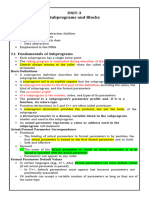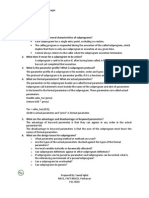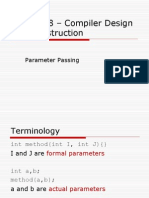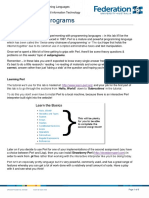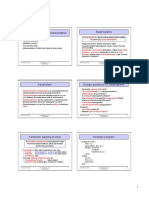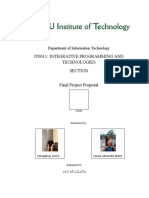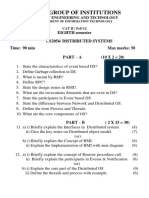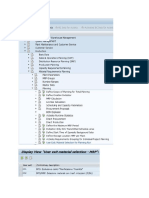Subprograms
In Text: Chapter 9
Outline
Definitions Referencing environments Parameter passing modes and mechanisms Advanced subprogram issues
Chapter 9: Subprograms
8-1
�Characteristics of Subprograms
Fundamental characteristics: A subprogram has a single entry point The caller is suspended during execution of the called subprogram Control always returns to the caller when the called subprograms execution terminates
Chapter 9: Subprograms
Actual/Formal Param Correspondence
Two basic choices: Positional Keyword Sort (List => A, Length => N); For Keyword association: Advantage: order is irrelevant Disadvantage: user must know the formal parameters names
Chapter 9: Subprograms
8-2
�Default Parameter Values
Example, in Ada:
procedure sort (list : List_Type; length : Integer := 100); ... sort (list => A);
Chapter 9: Subprograms
Design Issues for Subprograms
What parameter passing methods are provided? Are parameter types checked? Are local variables static or dynamic? What is the referencing environment of a passed subprogram? Are parameter types in passed subprograms checked? Can subprogram definitions be nested? Can subprograms be overloaded? Are subprograms allowed to be generic? Is separate/independent compilation supported?
Chapter 9: Subprograms
8-3
�Local Referencing Environments
If local variables are stack-dynamic:
Advantages: Support for recursion Storage for locals is shared among some subprograms Disadvantages: Allocation/deallocation time Indirect addressing Subprograms cannot be history sensitive
Static locals are the opposite
Chapter 9: Subprograms 7
Local Variables in Example PLs
FORTRAN 77 and 90most are static, but can have either (SAVE forces static) Cboth; default is stack dynamic, but variables declared to be static are not Pascal, Modula-2, and Adadynamic only
Chapter 9: Subprograms
8-4
�Parameters and Parameter Passing
Semantic Models: in mode, out mode, inout mode Conceptual Models of Transfer:
Physically move a value Move an access path
Implementation Models:
Pass-by-value Pass-by-result Pass-by-value-result Pass-by-reference Pass-by-name
Chapter 9: Subprograms
Pass-By-Value
in mode Either by physical move or access path Disadvantages of access path method: Must write-protect in the called subprogram Accesses cost more (indirect addressing) Disadvantages of physical move: Requires more storage Cost of the moves
Chapter 9: Subprograms
10
8-5
�Pass-By-Result
out mode Locals value is passed back to the caller Physical move is usually used Disadvantages: If value is moved, time and space In both cases, order dependence may be a problem procedure sub1(y: int, z: int); ... sub1(x, x); Value of x in the caller depends on order of assignments at the return
Chapter 9: Subprograms 11
Pass-By-Value-Result
inout mode Physical move, both ways Also called pass-by-copy Disadvantages: Those of pass-by-result Those of pass-by-value
Chapter 9: Subprograms
12
8-6
�Pass-By-Reference
inout mode Pass an access path Also called pass-by-sharing Advantage: passing process is efficient Disadvantages: Slower accesses Can allow aliasing:
Root cause of all of these is: The called subprogram is provided wider access to nonlocals than is necessary Pass-by-value-result does not allow these aliases (but has other problems!)
Chapter 9: Subprograms 13
Actual parameter collisions: sub1(x, x); Array element collisions: sub1(a[i], a[j]); /* if i = j */ Collision between formals and globals
Ex: value/result vs. reference
program foo; var x : int; procedure p(y : int); begin y := y + 1; y := y * x; end; value/result begin xy x := 2; (entry to p) 2 2 (after y := y + 1) 2 3 p(x); (at p's return) 6 (6)* print(x) * Actually NOT available after the return end.
Here, y is an alias for x
reference
xy 2 2 33 9 (9)*
Chapter 9: Subprograms
14
8-7
�Pass-By-Name
multiple modes By textual substitution Formals are bound to an access method at the time of the call, but actual binding to a value or address takes place at the time of a reference or assignment Purpose: flexibility of late binding Resulting semantics:
If actual is a scalar variable, it is pass-by-reference If actual is a constant expression, it is pass-by-value If actual is an array element, it is like nothing else If actual is an expression with a reference to a variable that is also accessible in the program, it is also like nothing else
Chapter 9: Subprograms 15
Pass-By-Name Example 1
procedure sub1(x: begin x := 1; y := 2; x := 2; y := 3; end; sub1(i, a[i]); int; y: int); i := a[i] := i := a[i] := 1; 2; 2; 3;
Chapter 9: Subprograms
16
8-8
�Pass-By-Name Example 2
Assume k is a global variable
procedure sub2(x: int; y: int; z: int); begin k := 1; k := 1; j := k+1; y := x; k := 5; k := 5; i := k+1; z := x; end; sub2(k+1, j, i);
Chapter 9: Subprograms
17
Pass-by-Name (continued)
procedure p1; var x:int; begin x := 2; p2(x+1); end; procedure p2(y:int); var x:int; begin x := 5; glob := x + y end;
===>
x + (x + 1) => p2.x + (p1.x + 1)
Now: glob = 11 or 8?
Chapter 9: Subprograms 18
8-9
�Disadvantages of Pass-By-Name
Very inefficient references Too tricky; hard to read and understand re-evaluation of actuals need thunk = (code,env)
Special implementation issue
Chapter 9: Subprograms
19
THUNKS (aka Jensens Device)
A Thunk is a parameterless* function, that exists in the calling program that evaluates the argument A parameter reference in the called program compiles as a call to the corresponding Thunk
proc BLOP (X) call BLOP (A+B: by name) Thunk to compute A+B (in local env) return point ref X
CALLER
return
Chapter 9: Subprograms 20
8-10
�Param Passing: Language Examples
FORTRAN Before 77, pass-by-reference 77scalar variables are often passed by valueresult ALGOL 60 Pass-by-name is default; pass-by-value is optional ALGOL W: Pass-by-value-result C: Pass-by-value Pascal and Modula-2: Default is pass-by-value; pass-by-reference is optional
Chapter 9: Subprograms 21
Param Passing: PL Examples (cont.)
C++: Like C, but also allows reference type parameters, which provide the efficiency of passby-reference with in-mode semantics Ada All three semantic modes are available If out, it cannot be referenced If in, it cannot be assigned Java Like C++, except only references
Chapter 9: Subprograms 22
8-11
�Implementing Parameter Passing
ALGOL 60 and most of its descendants use the run-time stack Valuecopy it to the stack; references are indirect to the stack Resultsame Referenceregardless of form, put the address in the stack Name:
Run-time resident code segments or subprograms evaluate the address of the parameter Called for each reference to the formal These are called thunks Very expensive, compared to reference or value-result
Chapter 9: Subprograms 23
Multidimensional Arrays as Params
If a multidimensional array is passed to a subprogram and the subprogram is separately compiled, the compiler needs to know the declared size of that array to build the storage mapping function C and C++
Programmer is required to include the declared sizes of all but the first subscript in the actual parameter This disallows writing flexible subprograms Solution: pass a pointer to the array and the sizes of the dimensions as other parameters; the user must include the storage mapping function, which is in terms of the size parameters (See example, p. 351)
Chapter 9: Subprograms 24
8-12
�More Array Passing Designs
Pascal
Not a problem (declared size is part of the arrays type)
Ada
Constrained arrayslike Pascal Unconstrained arraysdeclared size is part of the object declaration (See book example p. 351)
Pre-90 FORTRAN
Formal parameter declarations for arrays can include passed parameters SUBPROGRAM SUB(MATRIX, ROWS, COLS, RESULT) INTEGER ROWS, COLS REAL MATRIX (ROWS, COLS), RESULT ... END
Chapter 9: Subprograms 25
Design Considerations for Parameter Passing
Efficiency One-way or two-way These two are in conflict with one another! Good programming => limited access to variables, which means one-way whenever possible Efficiency => pass by reference is fastest way to pass structures of significant size Also, functions should not allow reference parameters
Chapter 9: Subprograms 26
8-13
�Subprograms As Parameters: Issues
Are parameter types checked? Early Pascal and FORTRAN 77 do not Later versions of Pascal, Modula-2, and FORTRAN 90 do Ada does not allow subprogram parameters C and C++pass pointers to functions; parameters can be type checked
Chapter 9: Subprograms
27
Subprogs as Params: Issues (cont.)
What is the correct referencing environment for a subprogram that was sent as a parameter?
Possibilities:
It is that of It is that of It is that of never been the subprogram that called it (shallow binding) the subprogram that declared it (deep binding) the subprogram that passed it (ad hoc binding, used)
For static-scoped languages, deep binding is most natural For dynamic-scoped languages, shallow binding is most natural
Chapter 9: Subprograms
28
8-14
�Procedure and Function Arguments
program p123(); procedure p1(p); /* p is a procedure parameter */ var x: int; begin {p1} x := 1; /* the passed procedure is invoked */ p(); ed end; {p1} end; {p3} begin {p2} x := 2; p1(p3) end {p2} begin {main} p2(); end. {p123} Note: This requires thunks for static scoping (deep binding).
Chapter 9: Subprograms 29
procedure p2(); var x : int; /* Note: p3 not normally visible to p1 */ procedure p3(); begin {p3} /* X must be the x in p2, not the x in p1! */ print (x)
Overloading
An overloaded subprogram is one that has the same name as another subprogram in the same referencing environment C++ and Ada have overloaded subprograms built-in, and users can write their own overloaded subprograms Signature used to determine which overloaded subprogram is being referenced
Parameter number Parameter types Return value
Chapter 9: Subprograms 30
8-15
�Generic Subprograms
A generic or polymorphic subprogram is one that takes parameters of different types on different activations Overloaded subprograms provide ad hoc polymorphism A subprogram that takes a generic parameter that is used in a type expression that describes the type of the parameters of the subprogram provides parametric polymorphism See Ada generic and C++ template examples in text
Chapter 9: Subprograms 31
Functions
Design Issues: Are side effects allowed?
Two-way parameters (Ada does not allow) Nonlocal reference (all allow)
What types of return values are allowed?
FORTRAN, Pascal, Modula-2: only simple types C: any type except functions and arrays Ada: any type (but subprograms are not types) C++ and Java: like C, but also allow classes to be returned
Chapter 9: Subprograms 32
8-16
�Accessing Nonlocal Environments
The nonlocal variables of a subprogram are those that are visible but not declared in the subprogram Global variables are those that may be visible in all of the subprograms of a program
Chapter 9: Subprograms
33
Methods for Accessing Nonlocals
FORTRAN COMMON
The only way in pre-90 FORTRANs to access nonlocal variables Can be used to share data or share storage
Static scopingdiscussed in Chapter 4 External declarations: C
Subprograms are not nested Globals are created by external declarations (they are simply defined outside any function) Access is by either implicit or explicit declaration Declarations (not definitions) give types to externally defined variables (and say they are defined elsewhere)
External modules: Ada and Modula-2: Sec Ch. 10 Dynamic Scope: discussed in Ch. 4
Chapter 9: Subprograms 34
8-17
�User-Defined Overloaded Operators
Nearly all programming languages have overloaded operators Users can further overload operators in C++ and Ada (not carried over into Java) Ada Example (where Vector_Type is an array of Integers):
function "*"(a, b : in Vector_Type) return Integer is sum : Integer := 0; begin for index in a'range loop sum := sum + a(index) * b(index); end loop; return sum; end "*";
Are user-defined overloaded operators good or bad?
Chapter 9: Subprograms 35
Coroutines
A coroutine is a subprogram that has multiple entries and controls them itself Also called symmetric control A coroutine call is named a resume The first resume of a coroutine is to its beginning, but subsequent calls enter at the point just after the last executed statement in the coroutine Typically, coroutines repeatedly resume each other, possibly forever Coroutines provide quasiconcurrent execution of program units (the coroutines) Their execution is interleaved, but not overlapped
Chapter 9: Subprograms 36
8-18


















